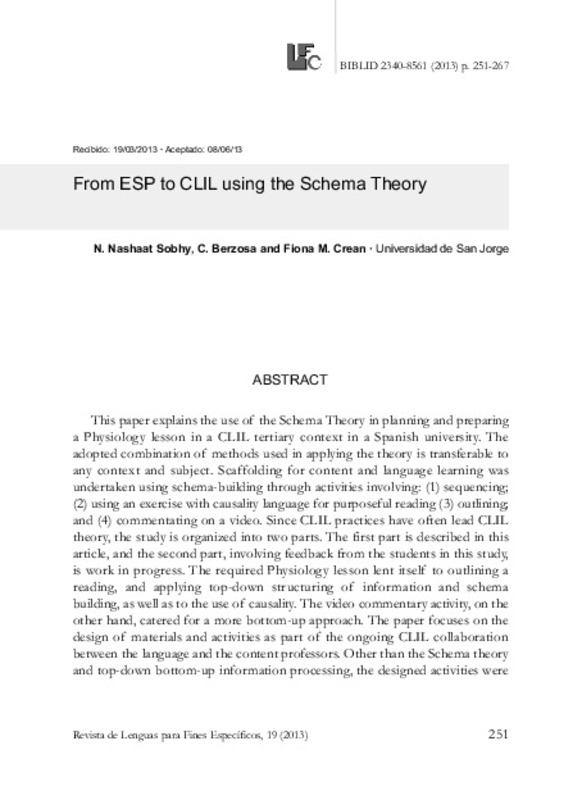JavaScript is disabled for your browser. Some features of this site may not work without it.
Buscar en RiuNet
Listar
Mi cuenta
Estadísticas
Ayuda RiuNet
Admin. UPV
From ESP to CLIL using Schema Theory
Mostrar el registro sencillo del ítem
Ficheros en el ítem
| dc.contributor.author | Nashaat-Sobhy, Nashwa
|
es_ES |
| dc.contributor.author | Berzosa, C.
|
es_ES |
| dc.contributor.author | Crean, Fiona M.
|
es_ES |
| dc.date.accessioned | 2024-04-26T18:02:49Z | |
| dc.date.available | 2024-04-26T18:02:49Z | |
| dc.date.issued | 2013-11-01 | es_ES |
| dc.identifier.issn | 1133-1127 | es_ES |
| dc.identifier.uri | http://hdl.handle.net/10251/203800 | |
| dc.description.abstract | [EN] This paper explains the use of the Schema Theory in planning and preparing a Physiology lesson in a CLIL tertiary context in a Spanish university. The adopted combination of methods used in applying the theory is transferable to any context and subject. Scaffolding for content and language learning was undertaken using schema-building through activities involving: (1) sequencing;(2) using an exercise with causality language for purposeful reading (3) outlining; and (4) commentating on a video. Since CLIL practices have often lead CLIL theory, the study is organized into two parts. The first part is described in this article, and the second part, involving feedback from the students in this study,is work in progress. The required Physiology lesson lent itself to outlining a reading, and applying top-down structuring of information and schema building, as well as to the use of causality. The video commentary activity, on the other hand, catered for a more bottom-up approach. The paper focuses on the design of materials and activities as part of the ongoing CLIL collaboration between the language and the content professors. Other than the Schema theory and top-down bottom-up information processing, the designed activities were based on the principles of social constructivism through language scaffolding and peer collaboration. | es_ES |
| dc.language | Inglés | es_ES |
| dc.publisher | Serv. Publicaciones de la Universidad de Las Palmas de Gran Canaria | es_ES |
| dc.relation.ispartof | LFE. Revista de Lenguas para Fines Específicos | es_ES |
| dc.rights | Reconocimiento - No comercial - Sin obra derivada (by-nc-nd) | es_ES |
| dc.subject | Schema theory | es_ES |
| dc.subject | Top-down and bottom-up information processing | es_ES |
| dc.subject | Scaffolding | es_ES |
| dc.subject | CLIL and ESP for Physiology in Sport Sciences | es_ES |
| dc.subject.classification | FILOLOGIA INGLESA | es_ES |
| dc.title | From ESP to CLIL using Schema Theory | es_ES |
| dc.type | Artículo | es_ES |
| dc.rights.accessRights | Abierto | es_ES |
| dc.contributor.affiliation | Universitat Politècnica de València. Escuela Politécnica Superior de Gandia - Escola Politècnica Superior de Gandia | es_ES |
| dc.description.bibliographicCitation | Nashaat-Sobhy, N.; Berzosa, C.; Crean, FM. (2013). From ESP to CLIL using Schema Theory. LFE. Revista de Lenguas para Fines Específicos. (19):251-267. http://hdl.handle.net/10251/203800 | es_ES |
| dc.description.accrualMethod | S | es_ES |
| dc.relation.publisherversion | https://ojsspdc.ulpgc.es/ojs/index.php/LFE/article/view/19 | es_ES |
| dc.description.upvformatpinicio | 251 | es_ES |
| dc.description.upvformatpfin | 267 | es_ES |
| dc.type.version | info:eu-repo/semantics/publishedVersion | es_ES |
| dc.description.issue | 19 | es_ES |
| dc.relation.pasarela | S\401436 | es_ES |
| dc.subject.ods | 04.- Garantizar una educación de calidad inclusiva y equitativa, y promover las oportunidades de aprendizaje permanente para todos | es_ES |






